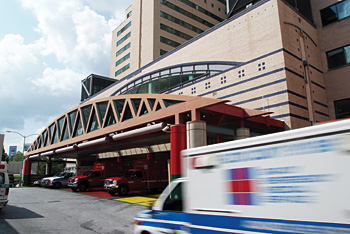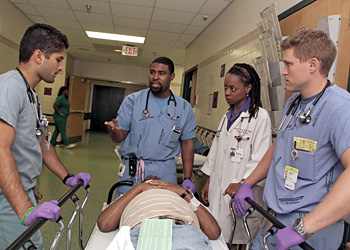Autumn 2007
Critical Condition
Atlanta’s troubled Grady Memorial Hospital is a lifesaver for the uninsured
More Grady Hospital Information
For the latest news on Grady, and for more information about Emory and Grady’s historic relationship, go to www.emory.edu/grady.
By Mary J. Loftus
When the chartered bus carrying an Ohio college baseball team crashed off an I-75 exit ramp and landed on the roadway below in the early morning hours of March 2, triage teams at the scene sent many of the injured athletes to Atlanta’s Grady Memorial Hospital.
Although Grady staff was in the middle of a shift change, says Chief of General Surgery Jeff Salamone, they stayed to help with the incoming patients, forming a line to receive the players, assessing injuries, and washing off fuel and dirt. Doctors quickly admitted those who needed surgery, hustling them through the Emergency Department to the back elevator that takes patients straight up to several operating rooms.

Code blue: Atlanta’s 115-year-old public hospital—the largest in the state—is facing a multimillion-dollar budget deficit that threatens its survival.
Jack Kearse
“Grady’s ORs are open around the clock,” says Salamone, who, like many doctors at Grady, is also a professor at Emory’s School of Medicine. “We have specially trained trauma teams always on site. And we have surge capacity—we can deal with large numbers of patients rolling in the door at once.”
But what happens, Salamone asks, if there is a bus accident, a Centennial Park bombing, a Buckhead day-trader shooting, and Grady is no longer there?
The 115-year-old public hospital—the largest in Georgia and the only Level 1 trauma unit for about a hundred miles in every direction—has been losing money since 2000. It faces a cash shortfall estimated at $120 million and could be forced to close if it can’t make payroll. Grady owes Emory alone $54 million in back payments.
The Emory and Morehouse schools of medicine supply the hospital with all its doctors under a contract with the Fulton-DeKalb Hospital Authority, which runs Grady. The hospital is supposed to pay the schools for the doctors, as well as for the services of about 375 residents. Grady is reimbursed for both residents’ salaries and faculty supervision of residents by federal and state programs.
Emory School of Medicine Dean Thomas Lawley and Morehouse School of Medicine Dean Eve Higginbotham wrote a combined editorial to the Atlanta Journal-Constitution about the value of staffing Grady with their faculty physicians and residents.

Life savers: Grady Memorial, with its Level 1 trauma center and diversity of patients, has long been a training ground for Emory and Morehouse residents.
Jack Kearse
“These doctors are in the trenches at Grady 24/7, providing all of the world-class medical care,” the editorial said. “When you read the phrase ‘Grady doctor,’ do a silent translation, because those words really mean either ‘Emory doctor’ or ‘Morehouse doctor.’ ”
The only reason Grady is still open today, they continued, is because both institutions “have not aggressively pursued payment for services, at a great fiscal cost to our respective schools. . . . such an ocean of red ink is not sustainable. We cannot continue to do business that way.” They suggest that, as recommended by the Greater Grady Task Force, the governance of the Grady Health System be immediately transformed based on a new business model, with renewed support from several layers of government for “this critically important, but gravely distressed, institution.”
Grady CEO Otis Story says the likelihood of Grady’s demise has been overstated, even though the hospital may have to scale back.
“You don’t lock the doors—you resize and keep tweaking until it works,” he told the Atlanta Journal-Constitution in early September. “It can continue to limp on.”
DeKalb and Fulton counties have contributed extra funds as stop-gap measures, but many at Grady say they would like to see the state step forward with more funding, since Grady serves Georgia residents outside the DeKalb and Fulton county lines.
Emory, particularly the medical school, has had a long relationship with Grady dating back to the public hospital’s founding in 1892. The hospital serves as a training ground for residents, who must address complex mental health issues; car crash, gunshot, and stabbing traumas; and a range of infectious diseases. One-quarter of the doctors in Georgia were trained at Grady.
“The military sends their doctors to train here, due to the volume of patients we receive and the type of injuries we see,” says Associate Dean of Clinical Affairs William Sexson. “The magnitude of Grady is impressive. And there are a couple of things we’re seminal in—not just in the country, but in the world.”
On a tour of Grady’s sprawling building on the corner of Armstrong and Jesse Hill Jr. Drive, Sexson proudly shows that Grady is not the run-down, grim facility some might believe, but a high-tech, modern hospital. One of his favorite spots is the great lobby, with its stately marble and statues of Hygieia and Hippocrates.
Equally inspiring to Sexson, a neonatologist, is the perinatal center, which was established three decades ago and has become a model of baby and premature infant care for the state. The Angel 2 Neonatal Transport ambulance has saved tens of thousands of tiny lives, says Sexson, as he stands in the NICU looking over the smallest and sickest babies—many of whom are asleep in state-of-the-art, $35,000 isolettes.
Pockets of excellence, he says, include Grady’s reproductive health center, the only poison control center in the state (which fields 150,000 calls a year), the community mental health system, the infectious disease center, the sickle-cell center, the cancer center (which includes the Avon Foundation Comprehensive Breast Cancer Center), and the burn unit. The stroke center was the first in a public hospital to be certified as a Primary Stroke Center, due to its quick response time and innovative imaging techniques.
Some of Grady’s doctors are world-renowned and have written the classic textbook or training manual in their fields, from cardiothoracic surgery to health literacy. “We have such an abundance of unbelievable superstars,” says Sexson, “that it really makes you proud to be working here.”
About a thousand Emory employees are working at Grady on any given day, and over the span of a few months nearly two thousand Emory staff will pass through as they perform rotations, consultations, or research. “If Grady fails, not only will Emory sustain a financial loss, but we will lose also a distinctive and probably irreplaceable educational venue,” says President Jim Wagner. “And Atlanta would lose something that should be a national model and source of civic pride—an institution that offers cutting-edge health care to many who are without the financial means to access it otherwise.”
A loss of capacity at Grady would be compounded by the fact that DeKalb Medical Center has closed its trauma center. While DeKalb’s ER remains open, most trauma patients are taken to Grady, Gwinnett Medical Center, or Atlanta Medical Center.
Emory College junior Evan Kananack 09C and School of Medicine Professor and Grady doctor Neil Shulman have teamed up to film a documentary—Save Grady—that portrays Grady’s importance through staff experiences and patient stories.
Kananack and Shulman profile patients who received life-saving care at Grady even though they didn’t have medical insurance. Were Grady to close or drastically scale back, says Shulman, many would be left in dire straits, and remaining area hospitals’ ERs would be flooded with uninsured patients. “It’s time to stop overlooking the fact that Grady is not sufficiently funded,” he says. “The state needs to step up. Grady is a lifeboat in an ocean where the uninsured are drowning.”